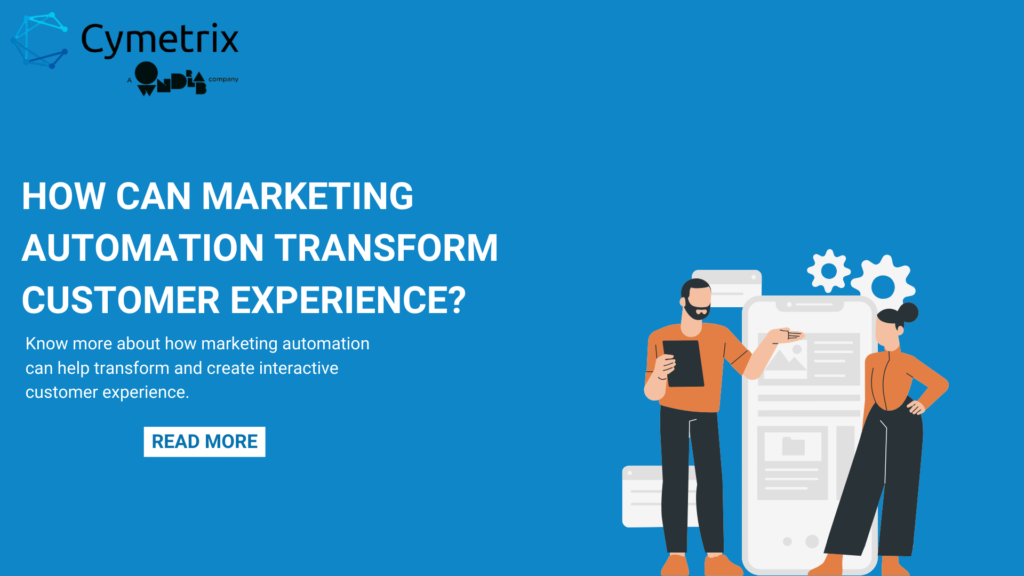
Are you tired of customers ignoring your marketing campaigns? It’s about time you unleash the power of interactive customer experience with marketing automation. Read more to learn how!
Have you ever felt your marketing communications stuck in a one-way conversation? Nowadays, customers crave experiences that ignite curiosity and leave them feeling like they are more than just another customer on the list.
But how do you bridge the gap between static messages and dynamic interactions? The answer lies in the powerful practice often thought to be limited to email automation and lead generation, i.e., Marketing Automation.
Marketing Automation, while traditionally focused on streamlining processes, is the key to unlocking interactive customer experiences that turn passive customers into active participants in your brand’s story.
But how? That’s what Cymetrix, a leading Salesforce Partner in the USA, is here to explain. With over eight years of experience as a Marketing Automation services provider, our team is here to highlight how you can use Marketing Automation to create interactive customer experience.
Marketing Automation: Creating Interactive Customer Experience
Do you know 91% of marketers say marketing automation helps them achieve their objectives? That clarifies the growing trend and need for marketing automation. However, how can you use it to create an interactive customer experience? Let’s take a look:
Engage with customers at multiple touchpoints
As a brand, you should ensure that customers receive relevant information at every stage of the customer’s journey. And guess what? Marketing automation is the key to fulfilling this role.
Not only does it help you deliver relevant content in real-time, but it also helps optimize user journeys based on behaviors and maintain consistency across multiple touchpoints.
But how can you get started?
First, we suggest integrating your CRM with a marketing automation platform (such as Pardot or Hubspot) and creating a centralized hub for customer data. With this integration, you can easily track and analyze customer interactions across various channels, such as website, social media, and email.
Then, you can create intricate workflows and automation rules that respond to customer actions and trigger messages and content across diverse channels.
You may want to read: Salesforce Pardot vs Marketing Cloud
Product Recommendations and Dynamic Search
Have you ever spent hours looking for a product on an Ecommerce website? Feel frustrating, right?
To avoid such a situation, you should employ an integration between your Ecommerce platform, marketing automation platform, and a recommendation engine (Sometimes available with a Marketing Automation platform). This integration can help process extensive datasets encompassing customer preferences, purchase history, and browsing behavior.
Then, the recommendation engine can generate real-time, context-aware product recommendations based on individual user profiles. Simultaneously, dynamic search experiences are optimized by continuously adapting product catalogs in response to user interactions.
This approach maximizes conversions and engagement by presenting relevant products to customers at the right time, all while streamlining the customer journey.
Deliver personalized Customer journeys
Are you aware of what the Customer journey is? To be precise- a customer journey starts with awareness (where a customer learns about a product or brand). Then, go through a series of steps until the customer purchases the product and eventually makes a repeated purchase.
But to ensure customer retention, you should focus on delivering a personalized experience throughout the customer journey. That’s where marketing automation steps in.
You can use customer data and behavior analytics for designing automated workflows within your Marketing Automation platforms. These workflows employ if-then logic, triggers, and conditions to respond dynamically to individual actions.
So, as users interact with brands across various touchpoints, the marketing automation system processes data in real-time, tailoring customer journeys based on their preferences and behaviors.
If you want to know more, see how Salesforce Marketing Cloud for Personalization, a marketing automation platform helps personalize customer experience.
Set up a chatbot for 24/7 support
Are you familiar with the fact that 55% of businesses report better quality leads because of the chatbot they use?
Now think about the possible leads you can lose if someone enquires when your sales team is unavailable. Similarly, what if your customer needs urgent support or resolution and your support team is unavailable?
These situations can lead to the loss of potential customers and existing customers. And that is why setting up a chatbot is vital for ensuring an interactive customer experience.
You can start by integrating the chosen chatbot tool with the marketing automation platform, ensuring a seamless flow of information between the two. So, a chatbot can access customer data, preferences, and interaction history stored in a marketing automation database.
As a result, your chatbot can use this trusted data to provide personalized and context-aware support, addressing customer queries, offering product recommendations, and guiding users through the purchase process.
Conclusion
So, no more one-sided marketing communication, unopened emails, or dissatisfied customers.
With marketing automation, you can transform every touchpoint into a captivating conversation and build marketing campaigns that leave customers in awe.
But if you’re feeling overwhelmed or need help getting started with Marketing Automation, contact Cymetrix. Our certified and experienced team is here to help you out. So, don’t wait- get started now!
